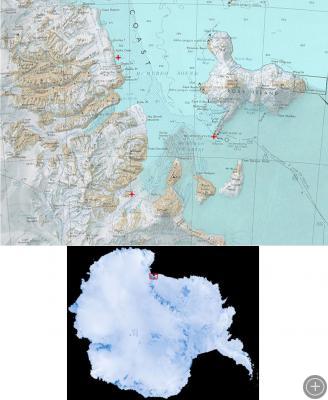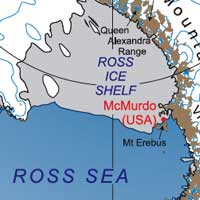Field Camp
MCMURDO STATION, ANTARCTICA– We’ve just returned from 2 weeks at Bay of Sails, where we were deploying SCINI to look at iceberg scours on the seafloor and the destruction, and recovery, of benthic communities there. All our high-tech science and engineering was supported out of the most primitive of camps. With just 6 of us, we had one shared operations and cooking tent, and 4 small backpacking tents for sleeping. These short vignettes of our activities give a sense of camp life outside of the intense work zone. (Music courtesy of Wayne Grim.)
Get the Flash Player to see this player.












Hello Ms. Kim,
I teach a class called World Explorations to sixth graders here in Florida, in the USA. My students have been learning about different areas of the world and now are exploring Antarctica. We have been reading about your project and viewed your videos, and would like to ask you some questions.
1. Is the water too cold under the ice for plants to grow? (Karleigh & Hadi)
2. When you dive down under the really thick ice, how do you get back up and out of the deep hole? (Michelle)
3. We noticed that you wear equipment that covers most of you when you dive in the frigid waters. How does the icy cold water affect your lips and the other areas that are exposed? (Luis)
4. Does the suit that you are wearing really keep you warm when you are diving under the ice? (Cheyenne)
5. How do you keep the hole in the ice which you have used for you SCINI or for diving, from icing over? (Grecia)
Hi Stacy,
Another great video. We all would like to try yoga in Antarctica! Quick question. Do you think you could take a picture of SCINI’s motor placement? We are working on maneuverability with our ROV right now and were wondering how you designed your prop placement for optimum maneuverability. Ohhh the students just reminded me of another question, is SCINI neutrally buoyant? Everything looks wonderful.
Smiles, Jillian and Class!
Hi Stacy,
I’m an PolarTREC teacher that just got back from the Arctic. I love your video – they give a great sense of daily life there. I also attempted some yoga while in the field. It was also challenging, as we were on a rocking boat! It’s a bit hard to balance while the ship is hitting pieces of ice!
I know that you also have a PolarTREC teacher with you. Tell Michelle I say hi and hope that you guys have a great field season!
-Cristina Galvan
I really loved the video,.
My top 3 favorites were hi from the cave
Sock soup
And the very hard yoga to do.But was the slipping and sliding part of the yoga moves??
Hoping the rest of your trip is just as much fun!
Hi Mrs. Hutchins World Explorations Class in Florida!
I’m glad to hear that you are exploring Antarctica, and your questions are great.
Karleigh and Hadi, the water is not too cold for plants to grow. It is minus 1.9 degrees C, but even at that low temperature plants can grow. The problem for plants, and for algae that grow in the ocean, is that the ice can be so thick that not enough light gets through for photosynthesis, which is how plants grow. So near McMurdo we have very little algae for the 10 months of the year when the sea surface is frozen, but then a bloom when the ice goes out.
Michelle, even though the ice is so thick, it is still floating on water, so most of the ice is below the surface of the water, and only 10% is above. That can still be more than a foot of ice in some places, so we have a rope ladder to help us climb out, as well as volunteer dive tenders who lift out our heavy tanks and weight belts before we climb out of the hole.
Luis, our lips get very cold when we dive. But your head and face have excellent blood flow, unlike your hands and feet, so it is not too bad. When we come up to the surface we often cannot talk very well because our lips are too cold to help us form sounds. We sound very funny, and our dive tenders have to get good at recognizing our confusing babble.
Cheyenne, we are wearing drysuits with really thick plush underwear – like snowmobiling suits – underneath them. I would not say we are warm when we are diving, but we are not so cold that we are miserable. And sometimes, the things that you are seeing are so beautiful that a little discomfort is worth it.
Grecia, one of most common things we do down here we call chipping and dipping. That is, we chip the ice in the hole and then dip it out. So the answer is, the hole does ice over, but we keep it open by breaking it up and cleaning it out constantly. That’s another thing our wonderful volunteer dive tenders get to do!
If you would like to see some more videos of SCINI and divers in action, Henry Kaiser has made several and posted them on You Tube. One example is at http://www.youtube.com/watch?v=slawv64kWyE
Best, Stacy
Hi Jillian and the New Start ROV builders,
There is a nice You Tube video at http://www.youtube.com/watch?v=slawv64kWyE that shows how SCINI moves, and where the thrusters are positioned. All five of SCINIs thrusters can run in forward and reverse. Because SCINI has such an awkward torpedo shape, she tends to move in one dimension (forward and back) very well. So we just have one powerful thruster to help her pull her tether in that dimension. To move sideways, SCINI has two maneuvering thrusters that allow her to not only translate left or right, but also to yaw or turn right or left. And there are two more maneuvering thrusters that move SCINI up and down, and also allow her to pitch, or tilt. All this gives SCINI complete maneuverability in three dimensions, with 5 axis of motion. As you can see in the video, SCINI is very responsive.
SCINI is neutrally buoyant, so that we do not have to fight to keep her off the bottom or from floating away. Though overall she is neutrally buoyant, she has a strong righting moment, which means that her floatation is positioned high and her weight is positioned low. This helps keep her from corkscrewing when her main prop is turning.
Have you decided how many thrusters your ROV will have? Sometimes you have to give up one or more axis of motion, so it can help to decide what motions are most critical to achieving your mission goals. Good luck and keep me posted on how things are progressing!
Best, Stacy
Hi Cristina,
I find yoga balance poses challenging even on solid land (or ice). I can imagine how difficult they are on a moving ship. Michele is heading for Happy Campers tomorrow (this is the nickname for the Snowcraft I course that teaches us the basics of surviving in the Antarctic should we get stuck anywhere) and I will forward your greeting to her.
Best, Stacy
Could the SCINI get destroyed by the pressure
Hi Landon,
SCINI could get damaged by pressure, if we dove her to deeper than her 300 m limit. The housings that protect her electronics are not strong enough to withstand pressure greater than 450 pounds per square inch.
Best, Stacy
Loved the movie Stacy- Good Work. Santa Cruz will seem like the tropics when you return.
Yes, this rain is seeming mighty tropical :)